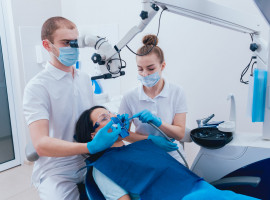Provider Miscommunication Causes Unintended Extraction
Case Study
Mario Catalano, DDS, MAGD
February 23, 2021
Reading time: 4 minutes

Background
In healthcare risk management, miscommunication is often a precursor to a misunderstanding and — ultimately — a mistake. The following case aptly illustrates how the likelihood of miscommunication is generally increased when a third party relays the information.
Case Discussion
This case involved a larger, mostly insurance-based practice that employed multiple dental specialties, including a part-time orthodontist, Dr. R. The practice had recently hired Dr. M, who had just finished her Advanced Education in General Dentistry (AEGD) program. As Dr. M was new and developing a patient base, the other dentists in the practice regularly referred patients to her.
The patient was a 9-year-old male who had a supernumerary tooth above tooth 8. As part of his orthodontic care, this supernumerary tooth needed to be extracted. Dr. R directed this patient to Dr. M for this extraction.
Dr. R submitted a request form for the extraction to the scheduling coordinator. Unfortunately, Dr. R’s handwriting was so illegible that the scheduling coordinator mistook it for a request to extract tooth 8 instead of the supernumerary tooth above it. She scheduled the extraction appropriately (but incorrectly) for tooth 8.
On the day of surgery, Dr. M reviewed the treatment plan on the computer and verified it by reviewing the panoramic X-ray. However, the X-ray was of poor quality, and it appeared to (the inexperienced) Dr. M that the root structure of tooth 8 was compromised by the position of the supernumerary tooth, making the extraction appropriate. Dr. R was not working that day, so Dr. M was unable to verify her conclusion with him, and she did not consult with any of the practice’s more experienced dentists. She extracted tooth 8 without any complications.
When the error was discovered at the next orthodontic appointment, the patient’s parents were promptly advised. The proposed treatment plan was to remove the supernumerary tooth and maintain the tooth 8 space with a cosmetically acceptable removable appliance until it could be replaced with an implant.
The practice offered to cover all costs associated with the remedial treatment; however, the parents withdrew the patient and ultimately commenced a dental malpractice lawsuit against Drs. R and M and the practice. The case was settled as to all parties by a payment in the midrange, with defense costs also in the midrange.
Risk Management Considerations
Theodore Passineau, JD, HRM, RPLU, CPHRM, FASHRM
Extracting the wrong tooth is not all that uncommon as orthodontists communicate with general or pediatric dentists or oral and maxillofacial surgeons. Usually, the problem involves differing numbering systems, human error in either writing or reading the order, poor penmanship, and more. In this case, a variety of risk factors combined to cause the error, including several wrong assumptions.
The first risk factor was Dr. R’s poor penmanship. The scheduling coordinator assumed that Dr. R meant tooth 8 rather than the supernumerary tooth. The potential for this mistaken assumption could have easily been eliminated by having the ordering doctor enter the order directly into the practice’s electronic health record (EHR). This entry would have eliminated the need for the scheduling coordinator to attempt to “decipher” Dr. R’s handwritten order. Whenever an additional person is introduced into the communication loop, the likelihood of miscommunication is exponentially increased.
The second risk factor was Dr. M’s review of the X-ray to confirm the order. Assuming that it was the correct X-ray (and nothing indicates it wasn’t), either the X-ray was of such poor quality that it was unable to facilitate an accurate diagnosis, or Dr. M was not experienced enough to recognize what was correctly displayed. If it was the former, another Panorex should have been taken; if it was the latter, Dr. M should have consulted a more experienced dentist before proceeding with an irreversible procedure. Knowing one’s limitations is a powerful risk management technique.
The third risk (or absent) factor was the communication between Drs. R and M and the parents. If Dr. R had clearly explained the problem and plan to resolve it to the parents, Dr. M would have had the opportunity to verify the planned procedure (the extraction of tooth 8) before its performance, and the parents would have had an opportunity to raise a “red flag.” Also, if these conversations did not occur, it is difficult to see how an adequate informed consent process took place.
One can reasonably speculate that if any of these errors had not occurred, the wrongful extraction ultimately would not have occurred.
One aspect of this case that was handled correctly was the disclosure of the error to the parents once it had been identified. The practice promptly consulted the parents, clearly explained what had occurred, apologized, and proposed a remedial treatment plan at its expense. Ultimately, the parents rejected the practice’s proposal; however, it was handled correctly from an ethical and strategic standpoint.
Conclusion
As the Institute of Medicine reminded us in 1999, “To Err Is Human.” All healthcare practitioners would be wise to be mindful of the inevitability of human error. Systems should be designed and regularly redesigned to minimize the potential for human error, and, when it does occur, to minimize the likelihood that it will negatively affect patient care.
Note that this case presentation includes circumstances from several different closed cases, in order to demonstrate certain legal and risk management principles, and that identifying facts and personal characteristics were modified to protect identities. The content within is not the original work of MedPro Group but has been published with consent of the author. Nothing contained in this article should be construed as legal, medical, or dental advice. Because the facts applicable to your situation may vary, or the laws applicable in your jurisdiction may differ, please contact your personal or business attorney or other professional advisors if you have any questions related to your legal or medical obligations or rights, state or federal laws, contract interpretation, or other legal questions.
Additional Risk Tips content

Protected: Patient Injured After Brick Flies Through Office Window
Risk Tips
Dentists can be sued for the most unexpected adverse outcomes. In this case study, learn what happens after a brick flies through an office window.

Managing Negative Online Reviews From Patients
Risk Tips
Online reputation is becoming increasingly important as patients turn to the internet for help finding their doctor. A risk management strategy can help.

Patient Sues Dentists for Trigeminal Neuralgia, Without Evidence
Risk Tips
Learn what can happen when a routine root canal therapy leads to a trigeminal neuralgia diagnosis and subsequent lawsuit.
This document does not constitute legal or medical advice and should not be construed as rules or establishing a standard of care. Because the facts applicable to your situation may vary, or the laws applicable in your jurisdiction may differ, please contact your attorney or other professional advisors if you have any questions related to your legal or medical obligations or rights, state or federal laws, contract interpretation, or other legal questions.
MedPro Group is the marketing name used to refer to the insurance operations of The Medical Protective Company, Princeton Insurance Company, PLICO, Inc. and MedPro RRG Risk Retention Group. All insurance products are underwritten and administered by these and other Berkshire Hathaway affiliates, including National Fire & Marine Insurance Company. Product availability is based upon business and/or regulatory approval and/or may differ among companies.
© MedPro Group Inc. All rights reserved.